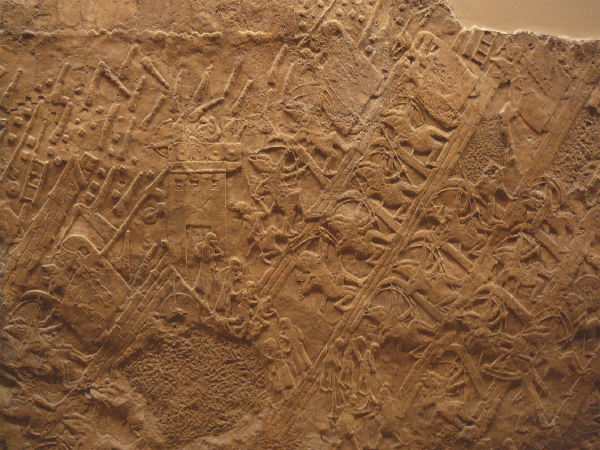Oracle against Tyre (23:1–18)
Tyre . . . Sidon (23:1–2). Tyre and Sidon were two of the main Phoenician cities in what is now southern Lebanon. The former was built on an island some six hundred yards offshore. It lay approximately twenty-five miles south of Sidon. Both cities served as seaports and trading centers, brokering products from inland as well as from across the waters.
The Phoenicians had associations with Israel throughout most of the monarchy period, with Hiram I of Tyre (980–950 B.C.) providing aid to both David and Solomon.648 Assyrian interest in the region was long-standing, with Tiglath-pileser I (1114–1076 B.C.) receiving tribute from this wealthy locale following a campaign in their area.649 Tiglath-pileser III records receiving tribute from “Hirummu [Hiram II] of Tyre.”650 Sennacherib speaks of overwhelming the Sidonian king and the city of Tyre.651 Phoenicians apparently tried to remain at least trading allies of Egypt against Assyria in this period, but they found no successful military alliance with them.
Ships of Tarshish (23:1). The description is ambiguous, since it could indicate either the vessel type or the place of origin. Etymologically related to smelting, these could be large ore ships, carrying crude ore to smelting sites or finished metal from them (e.g., 60:9). Some indications are geographical (e.g., v. 6), though the site of Tarshish is disputed, with suggestions ranging from Spain to Carthage.652
Cyprus (23:1, 12). Cyprus (Heb. kittîm) became a Phoenician colony just prior to this time period.653 Some Cypriotes lived in early sixth-century Arad as shown by their inclusion in Hebrew ration lists from that site, one of which says, “Give 4 baths of wine to the Kittim.”654 It fell to Sargon II in 709,655 at about the same time as did Midas, king of Phrygia,656 leaving Tyre and Sidon without important anti-Assyrian allies in the area.
Be silent (23:2). Silence (dmm) is appropriate in the presence of serious events or important people. It is contrasted to rejoicing or open grief. The Hebrew root apparently has a second, almost antonymous meaning of “weep, wail,” which equally well fits this context (v. 1). Facing death, a Ugaritic text urges, “Don’t you cry, don’t you wail/be silent (dmm) over me, don’t drain, O son, your eye’s spring . . . tears.”657
Fortress of the sea (23:4). Tyre’s location on an island is said in Egyptian and Assyrian sources to be “in the sea.”658 It lay about 2,000 feet offshore and so was relatively secure until a causeway was built out to it by Alexander the Great in about 332 B.C.659 While mentioned in the Amarna texts from the mid-second millennium, Tyre reached it peak under the Phoenicians during the time of David and Solomon, when it became a support trading partner of Israel. From there, Phoenician influence spread throughout the Mediterranean.

Relief on bronze bands of Balawat gate showing trading ships leaving Tyre
Werner Forman Archive/The British Museum
In addition to its protection by the sea, it also boasted large fortifying walls.660 The Tyrians in their island stronghold withstood capture by the Neo-Assyrian kings, though its mainland holdings were much more vulnerable. They did pay Assyria tribute, as Tiglath-pileser III records: “I sent an officer of mine, the rabšaq (see 36:2) to Tyre [and received] 150 talents of gold.”661
City of revelry (23:7). Arbela, a city in northeastern Mesopotamia, is described in a hymn: “Arbela, city of celebration. Arbela, city of festivals. Arbela, city of the palace of celebrations . . . city of celebrations. Arbela, dwelling place of jubilation.”662 While being the city where Ishtar dwelt, or perhaps because she, the goddess of sexuality and fertility, resided there, it is also a city of riotous life.
Bestower of crowns (23:8). Phoenicia’s power and wealth are such that even her merchants, the main source of her revenues, are like royalty. Their abundance of goods is shown by the tribute levied against them by Assyria under Shalmaneser III, pictured on the Balawat gates.663 A crown was worn by rulers and deities. The distinguishing feature between the two was the horns, or their symbolic representation, which often decorated the divine crown.664
Seventy years (23:15). A seventy-year period of Tyre’s destruction takes Israel’s history to the time of Josiah.665 The number is symbolic (“a king’s life”). An Esarhaddon inscription also refers to a seventy-year period of divine displeasure caused by people’s evil behavior, precipitating Marduk’s acting against them by sending them into slavery: “70 years, the calculated time of its abandonment.”666 Yahweh is claiming for himself the authority over foreign nations claimed elsewhere by Assyria’s gods.667
Hire as a prostitute (23:17). Prostitutes practiced their trade for payment. An Old Babylonian text refers to “the one who stands at the cross-roads and roams the streets,”668 though trade was also found in taverns.669 In a Ugaritic snake charm, the term used here (ʾtnn) is less specifically defined as a “gift”: “give a snake as [my dowry] and sons of snakes as my ‘gift.’ ”670
